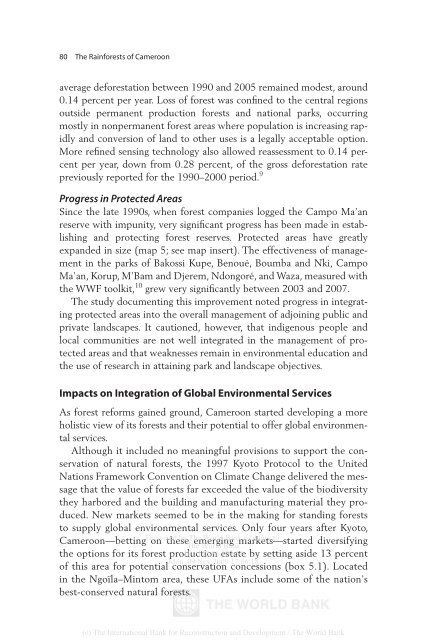The Rainforests of Cameroon - PROFOR
The Rainforests of Cameroon - PROFOR
The Rainforests of Cameroon - PROFOR
- No tags were found...
Create successful ePaper yourself
Turn your PDF publications into a flip-book with our unique Google optimized e-Paper software.
80 <strong>The</strong> <strong>Rainforests</strong> <strong>of</strong> <strong>Cameroon</strong>average deforestation between 1990 and 2005 remained modest, around0.14 percent per year. Loss <strong>of</strong> forest was confined to the central regionsoutside permanent production forests and national parks, occurringmostly in nonpermanent forest areas where population is increasing rapidlyand conversion <strong>of</strong> land to other uses is a legally acceptable option.More refined sensing technology also allowed reassessment to 0.14 percentper year, down from 0.28 percent, <strong>of</strong> the gross deforestation ratepreviously reported for the 1990–2000 period. 9Progress in Protected AreasSince the late 1990s, when forest companies logged the Campo Ma’anreserve with impunity, very significant progress has been made in establishingand protecting forest reserves. Protected areas have greatlyexpanded in size (map 5; see map insert). <strong>The</strong> effectiveness <strong>of</strong> managementin the parks <strong>of</strong> Bakossi Kupe, Benoué, Boumba and Nki, CampoMa’an, Korup, M’Bam and Djerem, Ndongoré, and Waza, measured withthe WWF toolkit, 10 grew very significantly between 2003 and 2007.<strong>The</strong> study documenting this improvement noted progress in integratingprotected areas into the overall management <strong>of</strong> adjoining public andprivate landscapes. It cautioned, however, that indigenous people andlocal communities are not well integrated in the management <strong>of</strong> protectedareas and that weaknesses remain in environmental education andthe use <strong>of</strong> research in attaining park and landscape objectives.Impacts on Integration <strong>of</strong> Global Environmental ServicesAs forest reforms gained ground, <strong>Cameroon</strong> started developing a moreholistic view <strong>of</strong> its forests and their potential to <strong>of</strong>fer global environmentalservices.Although it included no meaningful provisions to support the conservation<strong>of</strong> natural forests, the 1997 Kyoto Protocol to the UnitedNations Framework Convention on Climate Change delivered the messagethat the value <strong>of</strong> forests far exceeded the value <strong>of</strong> the biodiversitythey harbored and the building and manufacturing material they produced.New markets seemed to be in the making for standing foreststo supply global environmental services. Only four years after Kyoto,<strong>Cameroon</strong>—betting Delivered on these by <strong>The</strong> emerging World Bank markets—started e-library to: diversifying<strong>The</strong> World Bankthe options for its forest production IP : 192.86.100.34 estate by setting aside 13 percentMon, 09 Nov 2009 17:06:18<strong>of</strong> this area for potential conservation concessions (box 5.1). Locatedin the Ngoïla–Mintom area, these UFAs include some <strong>of</strong> the nation’sbest-conserved natural forests.(c) <strong>The</strong> International Bank for Reconstruction and Development / <strong>The</strong> World Bank
















